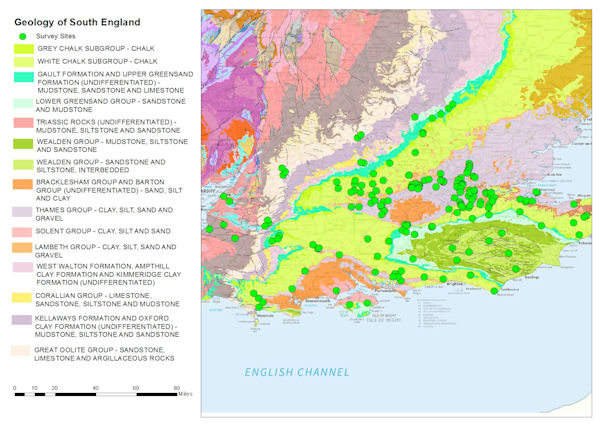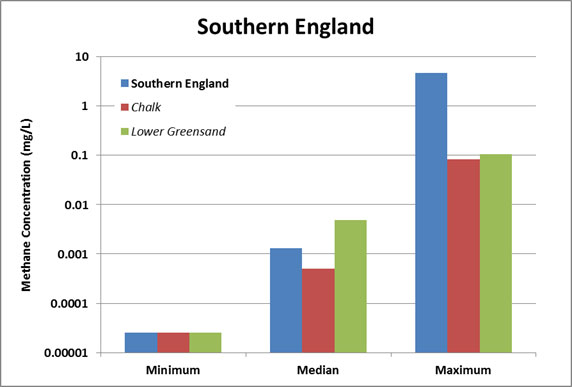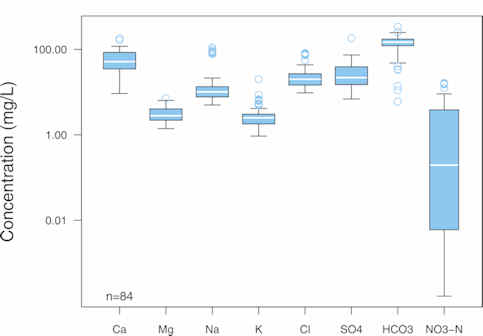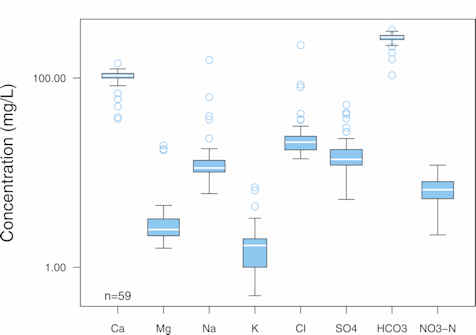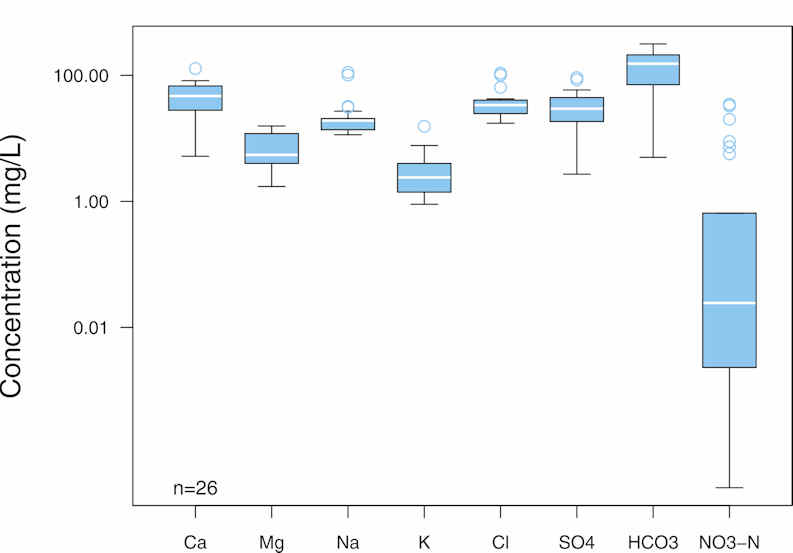Southern England
Regional summary
In the south of England, 251 sites have been sampled for methane from a number of different aquifers. The two main aquifers are the Chalk and the Lower Greensand.
- The Chalk is a principal aquifer in southern England, used extensively for public water supply. It has a high porosity but low matrix permeability, and groundwater flows through a well-developed interconnected network of fractures. The Chalk outcrops in the Chilterns, North and South Downs, Salisbury Plain, Wessex Downs and on the south coast. It reaches a maximum thickness of 200 m.
- The Lower Greensand aquifer consists of sands and sandstones, and groundwater flow is mainly through the pore spaces in the rock where the sand is unconsolidated. Groundwater from this aquifer is also used for public water supply. The Lower Greensand outcrops around the edge of the Weald and reaches a maximum thickness of 220 m.
The recent DECC report on the Weald Basin has reported that there is unlikely to be any shale gas potential in this region, but there could be shale oil reserves, although how much of this could be recovered is unknown. The shale units present in this region are the Kimmeridge and Ampthill Clays, Kellaways, Oxford Clay and Osgodby Formation and the Lias. The Kimmeridge and Amptill Clay consists of mainly black shales and the Kellaways, Oxford Clay and Osgodby Formation consist of mudstones, clays and siltstones.
Methane in UK groundwater results
These summaries are based on the results collected from single visits to each site for the purpose of the methane baseline project. The data are summarised for the Southern England region as a whole, and also for individual aquifers, where enough data are available.
The blue boxes highlight where summary data are available for baseline groundwater quality in the different aquifers present in this region, and link to the summaries for each region.
| Area | Concentration (mg/l) | Number of samples | ||
|---|---|---|---|---|
| Minimum | Median | Maximum | ||
| Southern England | <0.00005 | 0.0013 | 4.72 | 251 |
| Chalk | <0.00005 | 0.0005 | 0.083 | 137 |
| Greensand | <0.00005 | 0.0049 | 0.105 | 54 |
Baseline groundwater quality data in the Chalk of the North Downs, Kent and east Surrey
A summary of the baseline quality of groundwater in the Chalk of the North Downs, Kent and east Surrey is below. These data were collected as part of a collaborative project between BGS and the Environment Agency to investigate the baseline quality of groundwater in major UK aquifers. The UK baseline study results page provides downloads of all the reports produced by the project.
| Analysis | Concentration (mg/l) | Number of samples |
||
|---|---|---|---|---|
| Minimum | Median | Maximum | ||
| Ca | 15.7 | 116 | 399 | 132 |
| Mg | 1.1 | 2.8 | 689 | 132 |
| Na | 6.2 | 15 | 5820 | 132 |
| K | <0.4 | 1.92 | 175 | 132 |
| Cl | 10 | 26 | 10700 | 134 |
| SO4 | <10 | 21.4 | 1140 | 133 |
| HCO3 | 162 | 274 | 493 | 108 |
| NO3.N | <0.01 | 6.2 | 28.2 | 133 |
The Chalk in this region generally contains water of high quality, the main properties being determined by natural reactions between rainwater and the carbonate rock (HCO3). Groundwater is oxidising in the unconfined areas, but becomes rapidly reducing once confined by the Palaeogene deposits. The confined groundwaters are typically fresh and of pristine pre-industrial quality but may contain residual concentrations of chloride (Cl) from older water at depth. Some unconfined Chalk groundwaters show the effects of pollution from industrial, domestic and agricultural sources.
Baseline groundwater quality data in the Lower Greensand
A summary of the baseline quality of groundwater in the Lower Greensand is below. These data were collected as part of a collaborative project between BGS and the Environment Agency to investigate the baseline quality of groundwater in major UK aquifers. The UK baseline study results page provides downloads of all the reports produced by the project.
| Analysis | Concentration (mg/l) | Number of samples |
||
|---|---|---|---|---|
| Minimum | Median | Maximum | ||
| Ca | 9.3 | 51.4 | 182 | 84 |
| Mg | 1.4 | 2.8 | 7.17 | 84 |
| Na | 5 | 10.1 | 111 | 84 |
| K | 0.935 | 2.5 | 20 | 84 |
| Cl | 9.6 | 20 | 82 | 85 |
| SO4 | 6.9 | 21.6 | 182 | 84 |
| HCO3 | 6 | 148 | 339 | 81 |
| NO3.N | <0.003 | 0.196 | 16.3 | 68 |
The groundwater in the Lower Greensand is fresher than water from most other aquifers in the UK, mainly due to the relative purity of the sands and often short residence times. The low salinities of groundwater even in the deep confined parts of the aquifer show that it has been well flushed of any older water. Where the aquifer is confined, the groundwaters are more reducing and have higher iron concentrations.
Baseline groundwater quality data in the Chalk of Dorset
A summary of the baseline quality of groundwater in the Chalk of Dorset. These data were collected as part of a collaborative project between BGS and the Environment Agency to investigate the baseline quality of groundwater in major UK aquifers. The UK baseline study results page provides downloads of all the reports produced by the project.
| Analysis | Concentration (mg/l) | Number of samples |
||
|---|---|---|---|---|
| Minimum | Median | Maximum | ||
| Ca | 37 | 106 | 143 | 59 |
| Mg | 1.59 | 2.5 | 19.4 | 59 |
| Na | 6 | 11.2 | 155 | 59 |
| K | 0.5 | 1.7 | 7 | 33 |
| Cl | 14 | 21 | 223 | 59 |
| SO4 | <5 | 13.6 | 52.2 | 60 |
| HCO3 | 107 | 271 | 324 | 33 |
| NO3.N | <0.1 | 6.6 | 12 | 59 |
The Dorset Chalk contains groundwater predominately of very high quality. However, much of the area is farmed, the long term effects of which have impacted on the natural groundwater quality. The main observed effect of agricultural activity has been the increase in nitrate (NO3.N) and potassium (K) over several decades. Apart from these examples, there is no evidence of widespread contamination from urban and rural wastes or other sources of pollution. Oxidising conditions found in the unconfined aquifer rapidly give way to a reducing environment as the aquifer becomes confined beneath Palaeogene deposits.
Baseline groundwater quality data in the Palaeogene
A summary of the baseline quality of groundwater in the Palaeogene is below. These data were collected as part of a collaborative project between BGS and the Environment Agency to investigate the baseline quality of groundwater in major UK aquifers. The UK baseline study results page provides downloads of all the reports produced by the project.
| Analysis | Concentration (mg/l) | Number of samples |
||
|---|---|---|---|---|
| Minimum | Median | Maximum | ||
| Ca | 5.2 | 46.1 | 128 | 26 |
| Mg | 1.72 | 5.35 | 15.7 | 26 |
| Na | 11.4 | 19 | 111 | 26 |
| K | 0.9 | 2.4 | 15.5 | 26 |
| Cl | 17.4 | 33.3 | 108 | 26 |
| SO4 | 2.7 | 27.4 | 91.8 | 26 |
| HCO3 | 5 | 153 | 315 | 25 |
| NO3.N | <0.01 | 0.0244 | 34.8 | 26 |
The water quality of oxidising Palaeogene groundwaters of near-neutral pH is, in the most part, good. High iron and manganese as well as slightly acidic conditions are characteristics of the Palaeogene groundwaters. In these more acidic groundwaters, mobilisation of some trace metals can occur. Some unconfined waters in the Palaeogene are influenced by agricultural activities, showing elevated nitrate (NO3.N) concentrations. The hydrochemical properties of the groundwaters in the Palaeogene aquifers are primarily determined by natural reactions between recharge water and the Palaeogene host rocks.
Contact
Please contact BGS Enquiries for more information.


